Top 15 Canned Foods: Affordable and Nutritious
A clean, well-stocked pantry with canned goods makes preparing and enjoying inexpensive, healthful meals and snacks simple. Nutritionists strongly advise against consuming canned foods because of their adverse effects on health and convenience, especially those with low added sugar and sodium content. Dietary experts have shared their top 15 picks for the healthiest canned foods to help you stock your pantry efficiently.
15. Canned Tomatoes: A Key Ingredient for Wellness
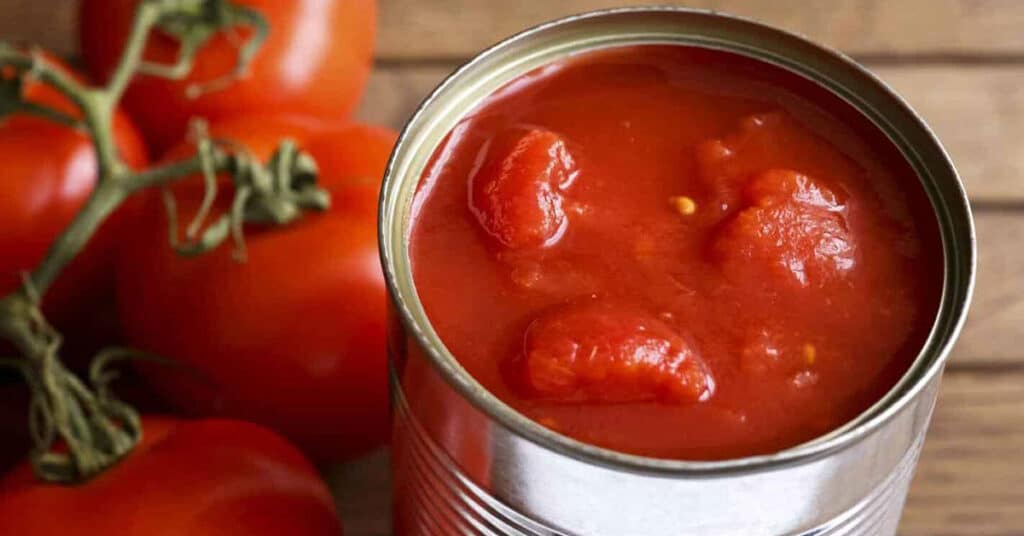
Because they are so convenient and packed with nutrients, canned tomatoes are a must-have for any pantry. They are rich in carotenoids, beta-carotene, lycopene, and vitamin C, as well as potassium and vitamin C. Because of their vital role in the fight against chronic illnesses, canned tomatoes are now more than just a flavor enhancer thanks to these antioxidants. They add flavor and health benefits to your food creations and are inexpensive and versatile.
Types of Canned Tomatoes:
- Whole Peeled Tomatoes: Best for when you want large chunks of tomato or wish to create your own puree or sauce texture.
- Diced Tomatoes: Great for stews, soups, and casseroles where you want the tomatoes to retain some shape.
- Crushed Tomatoes: A bit smoother than diced tomatoes, ideal for tomato-based soups and sauces.
- Tomato Puree: A thick, smooth consistency perfect for pasta sauces or dishes where you want a rich tomato flavor without chunks.
- Tomato Paste: Highly concentrated and used in small quantities to add depth and richness to sauces and dishes.
14. Canned Lentils: Your Quick Plant-Based Protein
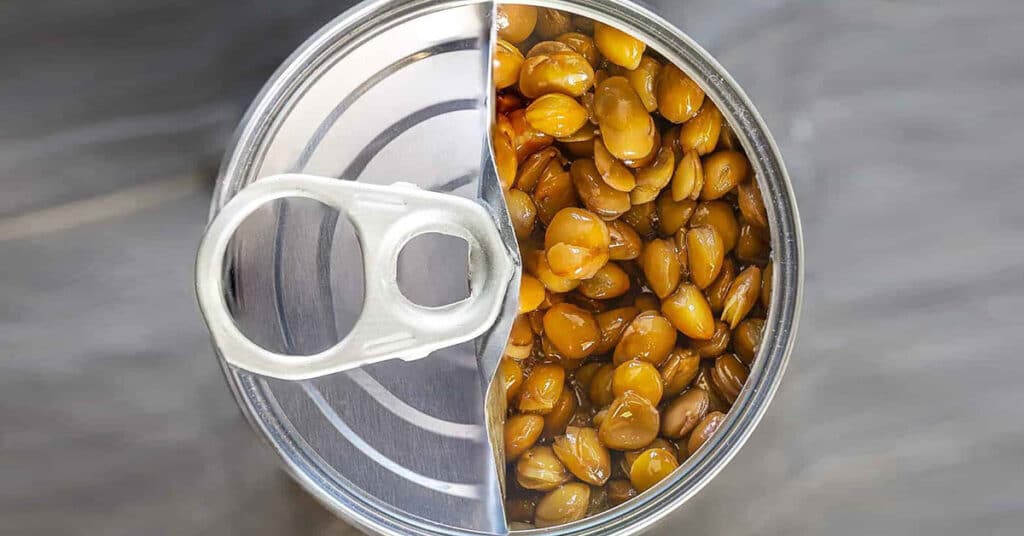
Canned lentils are a time-saving source of plant-based protein and fiber. They provide 9 to 14 grams of both per one-cup serving. With the cooking process removed, they’re a quick addition to salads, soups, and more. Opt for low or no-sodium canned lentils to lower sodium or rinse them before use—a convenient, nutritious choice for busy days.
Types of Canned Lentils:
-
Brown Lentils: The most common type found in canned form. They hold their shape well and have a mild, earthy flavor. Ideal for use in soups, stews and as a meat substitute in recipes.
-
Green Lentils: These can also be found canned and have a slightly peppery flavor. They’re firmer than brown lentils and work well in salads and side dishes where you want them to maintain shape.
-
Red and Yellow Lentils: Less common in canned form, these lentils are more petite and cook more quickly, often breaking down and becoming mushy. They are great for purees, dips, and Indian dishes like dals.
-
Beluga Lentils: Named for their resemblance to beluga caviar, these small, black lentils are known for their firm texture and rich flavor. They can be found canned, though less commonly than brown or green lentils.
-
Puy Lentils: French lentils are similar to green lentils but have a slightly firmer texture and a peppery taste. They may be available in canned form in some specialty stores.
13. Canned Fruits: Ready-to-Eat Goodness in Every Can
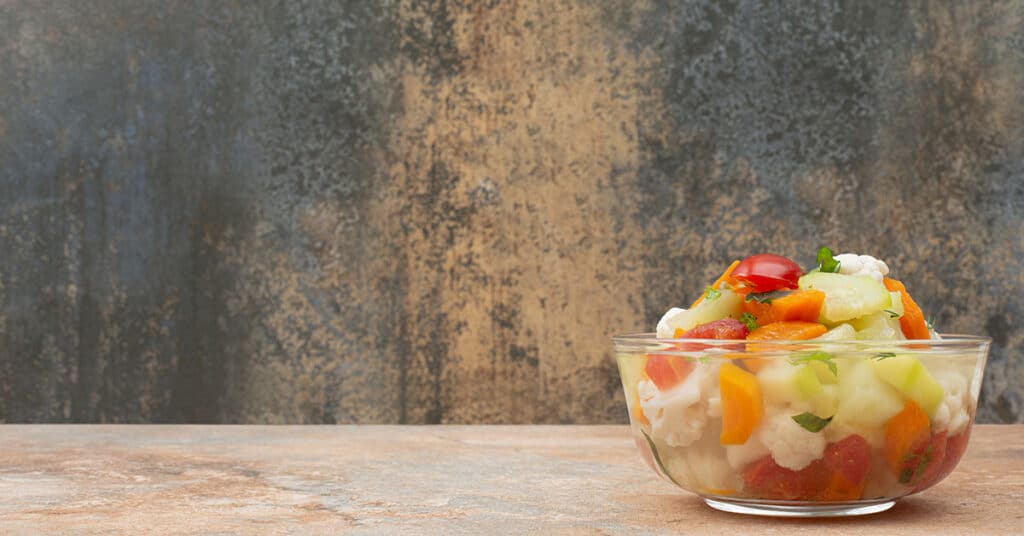
When planning stress-free camping meals, as outlined in the helpful tips from Simply Healthy Family, consider adding canned fruits to your camping pantry. Supermarkets offer a wide range of canned fruits brimming with essential vitamins and minerals, making them a healthful and convenient choice. These fruits come prepped, peeled, and ready to enjoy, a significant bonus for campers looking to save time and reduce meal prep hassle. Opting for fruits canned in water or natural juice ensures a nutritious addition to your outdoor meals, effortlessly complementing your camping breakfasts, snacks, or desserts. By incorporating these easy-to-carry and healthy canned fruits, you can further simplify your meal preparation and enhance your overall camping experience, keeping it enjoyable and stress-free.
Types of Canned Fruit:
- Peaches: Offer a sweet and juicy option for desserts or as a snack.
- Pineapple: Provides a tropical flavor, ideal for sweet and savory dishes.
- Pears: Delicate and sweet, perfect for desserts or as a side dish.
- Cherries: Great for baking, toppings, or adding a sweet touch to salads.
- Mixed Fruit Cocktail: A combination of various fruits, good for quick snacks or as a dessert topping.
12. Canned Chicken: A Versatile Pantry Staple
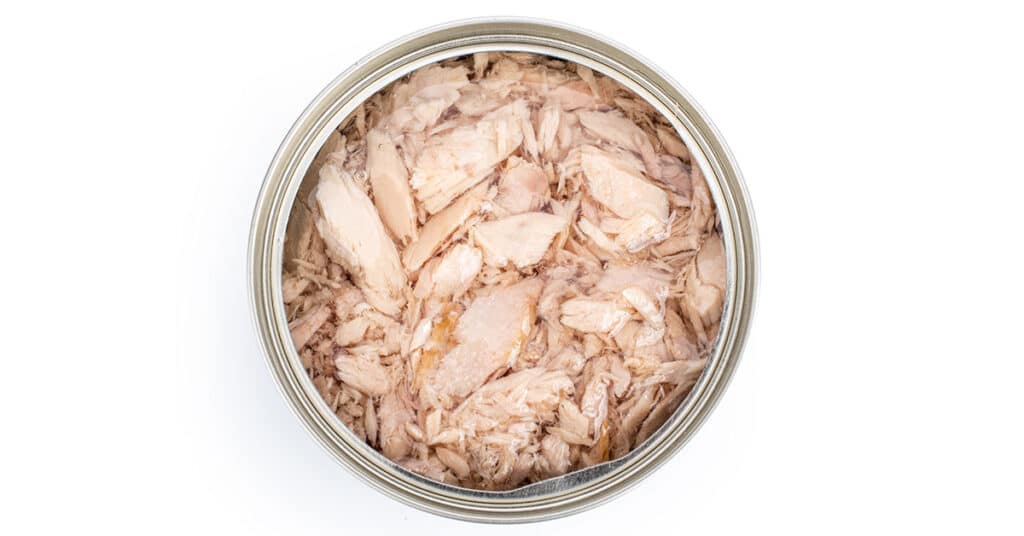
Canned chicken is a versatile and convenient source of lean protein. It’s perfect for creating chicken salads, adding to greens, or whipping up comfort foods like chicken pot pie. Plus, it’s a cost-effective, shelf-stable option that eliminates worries about spoilage.
Different types of canned chicken:
- Chicken Breast: Lean and convenient for salads and sandwiches.
- Chicken Chunks: Ideal for quick additions to soups, salads, and casseroles.
- In Water: Preserves natural flavor, lower in calories.
- In Broth: Adds extra flavor, suitable for soups and stews.
11. Canned Salmon: A Cost-Effective Seafood Choice

Canned fish, whether it’s tuna or salmon, offers an affordable way to enjoy the benefits of seafood. Packed with omega-3 fatty acids, vitamins, and minerals, canned salmon provide a nutritious punch without breaking the bank. Enjoy it straight from the can, toss it in salads, or whip up a quick and tasty tuna or salmon salad.
Types of Canned Salmon:
- Pink Salmon: Common and affordable, good for salads and sandwiches.
- Red Salmon (Sockeye): Richer in flavor and nutrients, great for gourmet dishes.
- In Water: Lower in calories and fat.
- In Oil: Adds richness, suitable for more flavorful dishes.
10. Canned Pumpkin: A Nutrient-Rich Pantry Staple
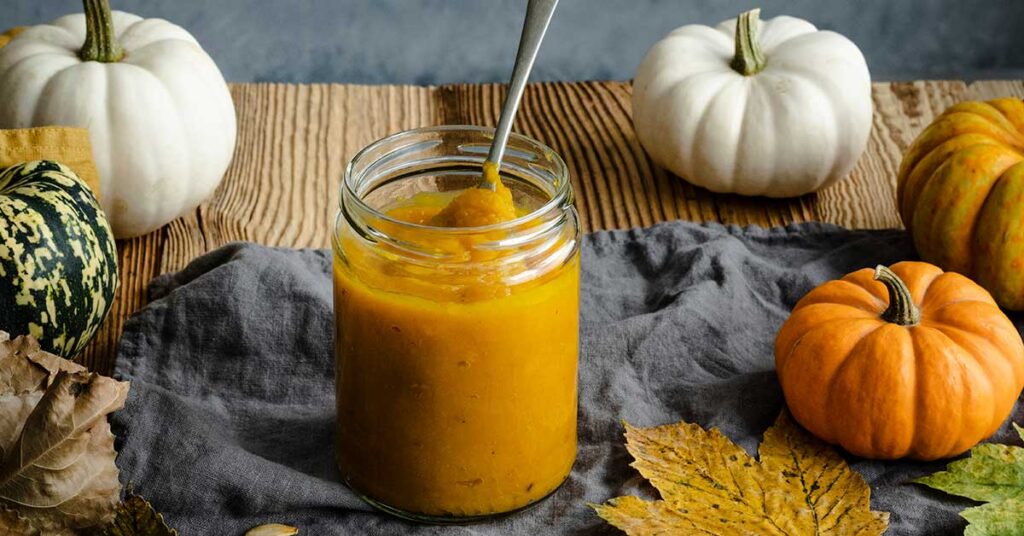
Full of essential vitamins, including A, C, and several B vitamins, canned pumpkin is a nutrient-dense gem and a culinary delight, especially in fall desserts. It offers beneficial antioxidants like beta- and alpha-carotene and a healthy dose of dietary fiber, making it a wholesome choice for various recipes. These health benefits come in a convenient, shelf-stable package that’s incredibly versatile. Canned pumpkin can enhance oatmeal in the morning, contribute to baked goods, and add flavor to your favorite tomato sauce. As my friend and many baking enthusiasts know, it is widely used in making pumpkin pie, a quintessential fall dessert. This aligns perfectly with the seasonal culinary explorations in ‘Falling for Fall Desserts: How To Get The Most Out of The Season This Year,’ where canned pumpkin is celebrated for its rich, comforting flavor and ease of use. It serves as a cornerstone ingredient in many autumn-themed recipes, showcasing its ability to bring the essence of fall to your table with minimal effort.
Types of Canned Pumpkin:
- Pure Pumpkin Puree: Smooth and versatile for baking and cooking.
- Pumpkin Pie Mix: Pre-spiced for convenient pie making.
9. Canned Beans: A Budget-Friendly Protein Source
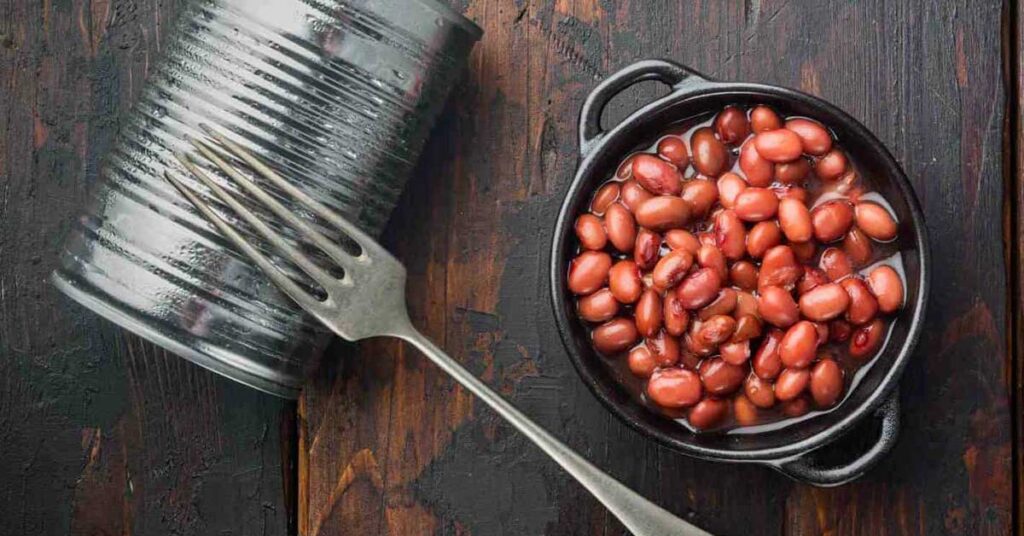
Rich in fiber, plant-based proteins, complex carbohydrates, and beneficial antioxidants, canned beans are a nutritional gem. It takes a quick rinse or drain to lower their sodium content drastically by about 40%. These pantry essentials provide a convenient and cost-effective means of infusing crucial nutrients into your diet, which is especially ideal for individuals with hectic schedules.
Types of Canned Beans:
- Black Beans: Versatile for various cuisines, rich in protein and fiber.
- Kidney Beans: Great in chili and stews, hearty texture.
- Pinto Beans: Common in Mexican cuisine, soft texture.
- Navy Beans: Small and mild, perfect for soups and baked beans.
8. Canned Chickpeas: A Versatile Plant-Based Protein
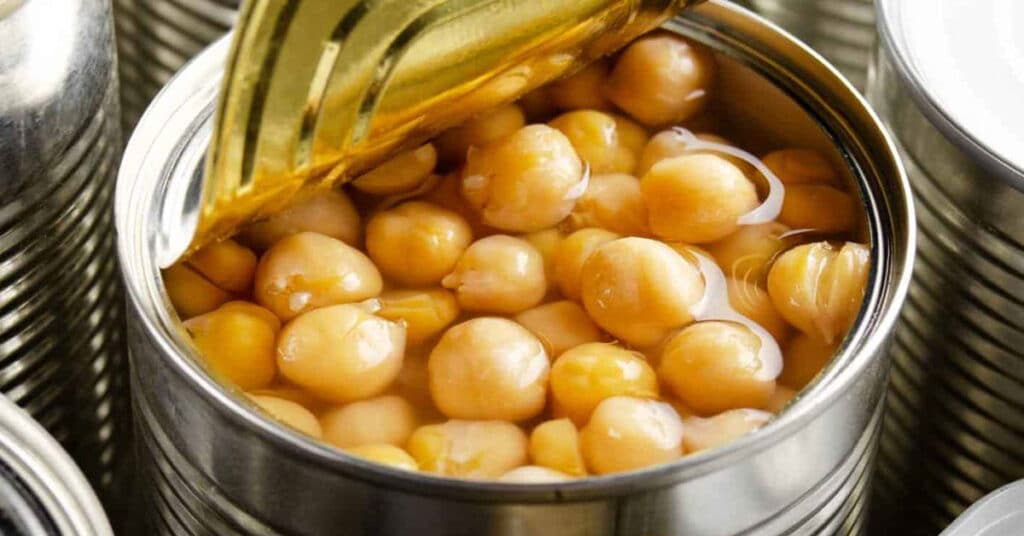
Canned chickpeas are a dietitian’s dream – they offer plant-based protein, versatility, and great taste. You can use them in tacos, power bowls, or vegetarian quesadillas. Rich in fiber and essential for gut health, blood sugar control, and heart health, these legumes are a wise choice, especially for those trying to conceive or pregnant.
Different types of canned chickpeas:
- In Water: Standard, versatile for various dishes.
- No-Salt-Added: Healthier option, lower in sodium.
- In Brine: Adds extra flavor, suitable for salads and hummus.
7. Canned Tuna: A Convenient Staple for Quick and Nutritious Meals
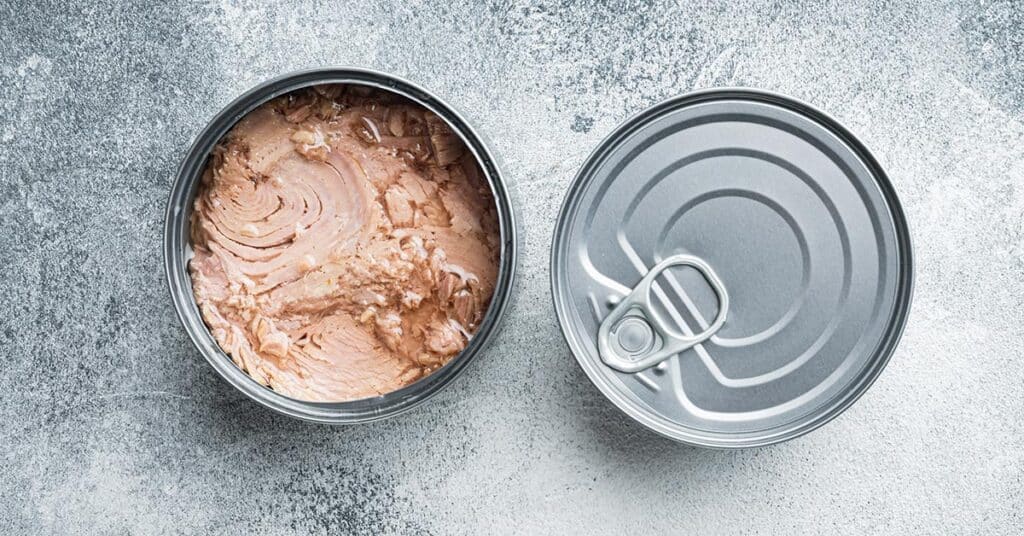
Canned tuna, renowned for its convenience and low-fat protein content, is an excellent addition to various dishes, ranging from simple lunches to satisfying casseroles. Not only is it a substantial source of essential vitamins and minerals, but it also adapts beautifully to various culinary styles. For a deeper dive into the benefits and nuances of this pantry staple, explore our insightful article, “The Truth About Canned Tuna: What You Need to Know,” where we unravel the facts and culinary possibilities of canned tuna.
Types of Canned Tuna:
- In Water: Lower in fat, retains natural tuna flavor.
- In Oil: Richer texture and flavor, great for salads.
- Chunk Light: Smaller pieces, less expensive.
- Albacore: Larger, firmer pieces, more flavorful.
- Flavored Tuna: Comes with added seasonings for instant meal prep.
6. Canned Peaches: The Ideal Snack for All Seasons
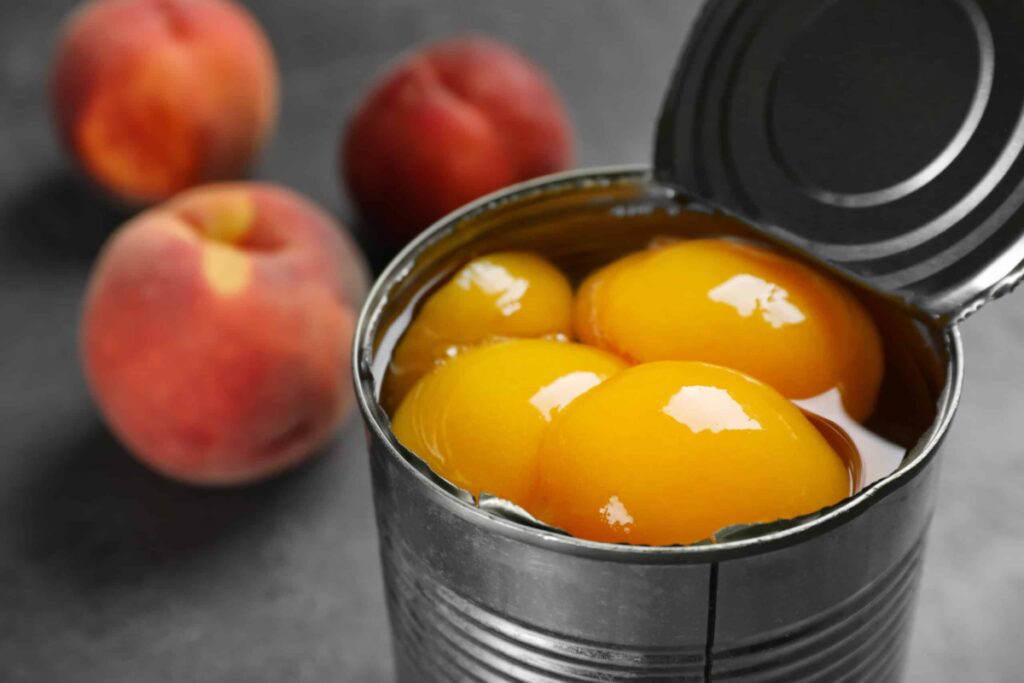
Canned peaches are a delightful pantry addition, offering year-round enjoyment. Packed just hours after being picked at peak ripeness, they retain optimal nutrients and flavor. For a flavorful bruschetta appetizer, Try them with goat cheese and basil on baguette slices.
Types of canned peaches:
- Halves: Large pieces, ideal for baking and grilling.
- Slices: Convenient for quick serving, desserts, and toppings.
- In Heavy Syrup: Sweeter option, great for desserts.
- In Juice: Healthier option less added sugar.
5. Sardines: A Sustainable Seafood Option
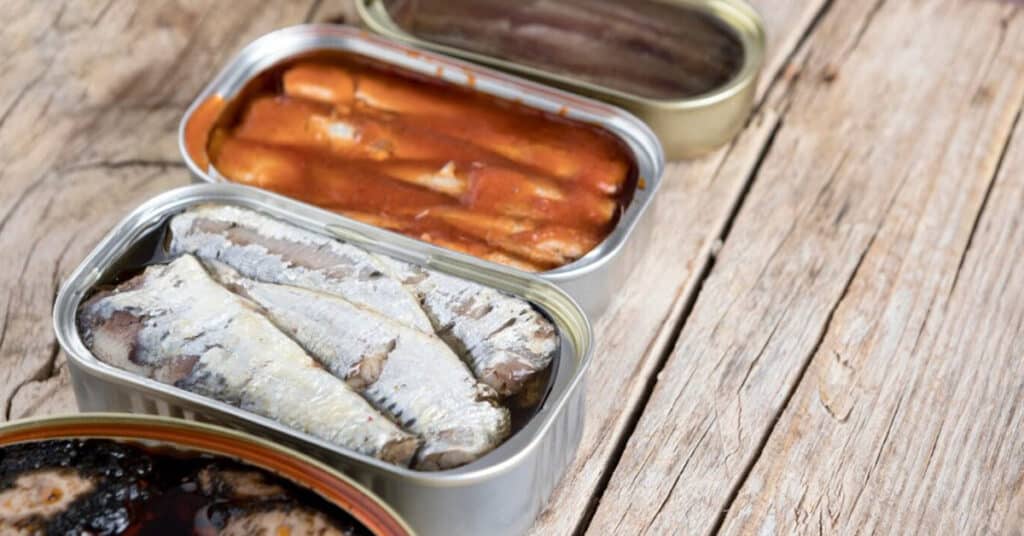
Canned sardines are nutritious and rich in omega-3 fatty acids for heart and brain health. Packed with protein, vitamin D, and B12, they even provide calcium through their edible bones. These sustainable seafood options align with eco-conscious dietary preferences.
Types of canned sardines:
- In Oil: Traditional, rich in flavor.
- In Water: Lighter option, focusing on the natural fish flavor.
- In Tomato Sauce: Adds a tangy flavor, suitable for pasta dishes.
- In Mustard Sauce: Zesty and flavorful, good for sandwiches.
- Spicy Sardines: Comes with added spices for a kick.
4. Canned Jackfruit: Your Vegan Meat Substitute
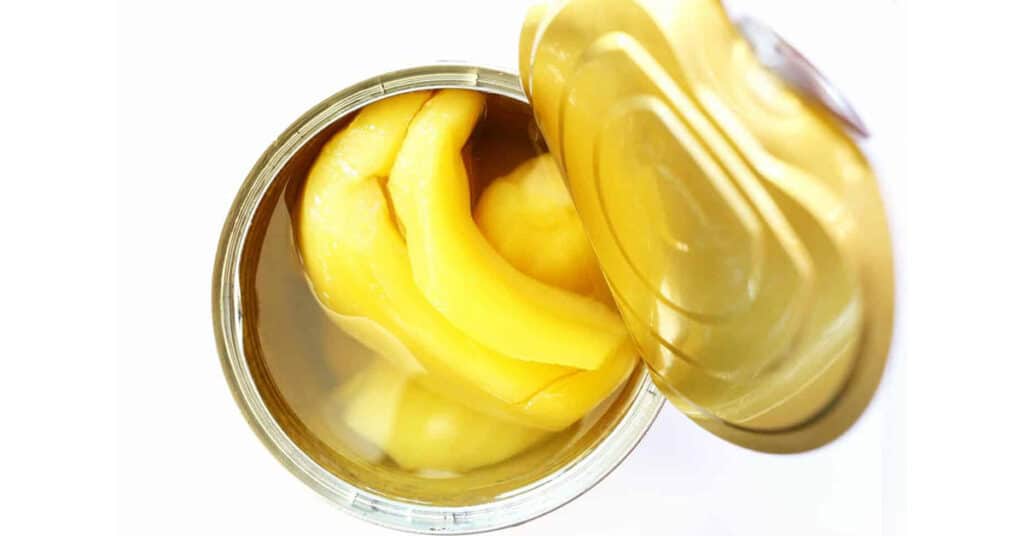
Canned jackfruit is a remarkably versatile ingredient, offering a meat-like texture for vegetarian and vegan dishes. Packed with dietary fiber, vitamins, and minerals like potassium and vitamin C, it’s a nutritious addition to your meals. Whether in savory recipes like barbecue-pulled jackfruit or sweet delights like jackfruit smoothies, this plant-based option is a culinary treasure worth exploring.
Types of Canned Jackfruit:
- Young Green Jackfruit: In brine or water, ideal for savory dishes.
- Ripe Jackfruit: In syrup, suitable for desserts and sweet recipes.
3. Safe Catch Salmon: Your Pantry Superfood
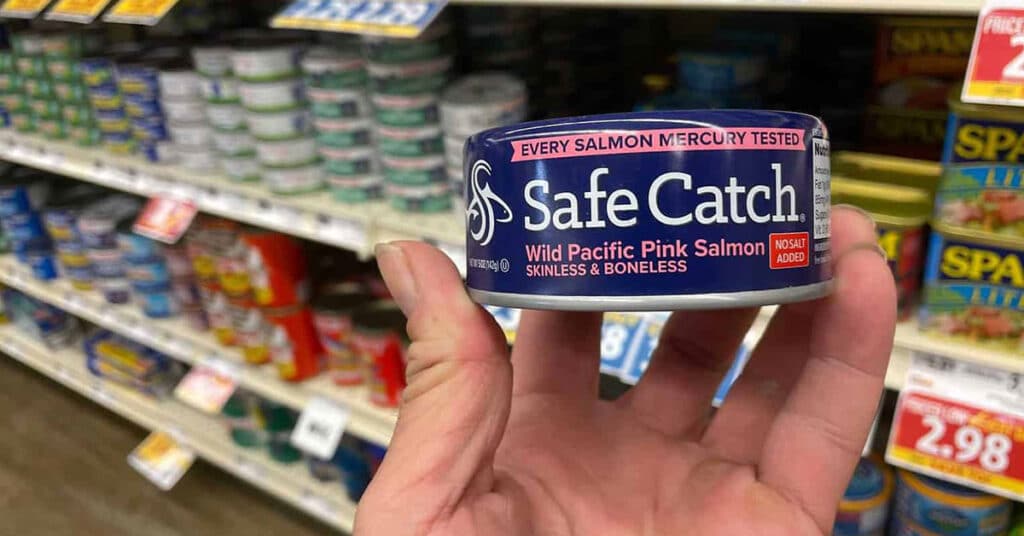
Safe Catch canned salmon is a pantry essential with impressive health benefits. It’s a convenient way to increase your seafood intake without the hassle of cooking. Its rigorous mercury testing makes it exceptional, ensuring mercury levels 25 to 50 times lower than the FDA limit. Packed with vital omega-3s and protein, Safe Catch salmon is a bright, healthy choice.
Different types of Safe Catch Salmon:
- Mercury Tested Wild Pink Salmon: Lower mercury, great for everyday meals.
- Mercury Tested Wild Sockeye Salmon: Rich in flavor, ideal for special dishes.
- No-Salt-Added Salmon: Healthier choice, lower in sodium.
2. Canned Pitted Black Olives: Yummy and Versatile Kitchen Essentials
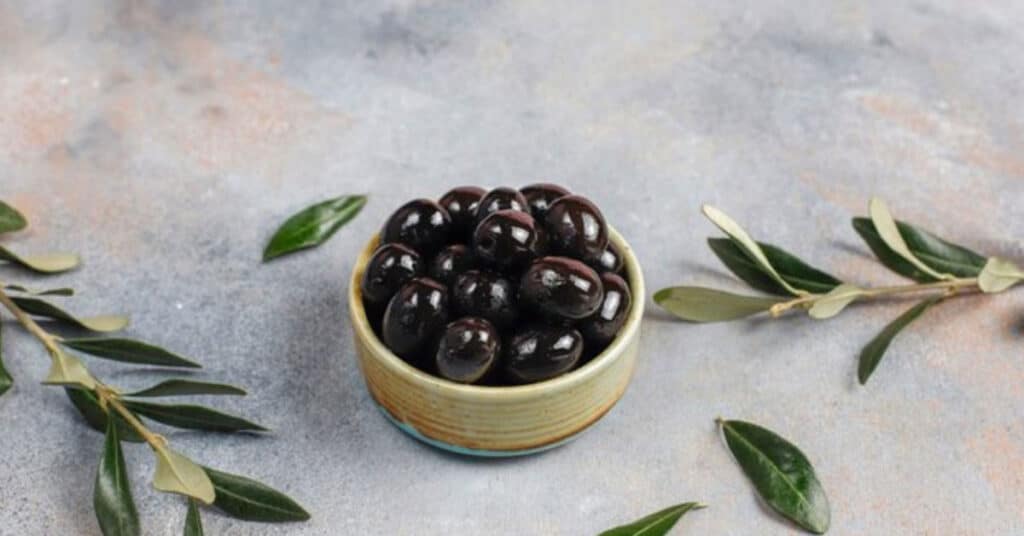
Canned, pitted black olives are your kitchen’s secret weapon. Elevate your dishes, whether topping a pizza or enhancing a snack board. Drain and rinse; they’re ready to bring their quality fats and rich flavor to your next culinary creation.
Different types of canned black olives:
- Whole Black Olives: Ideal for garnishes and whole olive dishes.
- Sliced Black Olives: Ready for pizza toppings and salads.
- Chopped Black Olives: Convenient for spreads and mixed dishes.
- Black Olive Tapenade: Ready-made spread for appetizers and sandwiches.
1. Canned Soup: Convenient and Comforting
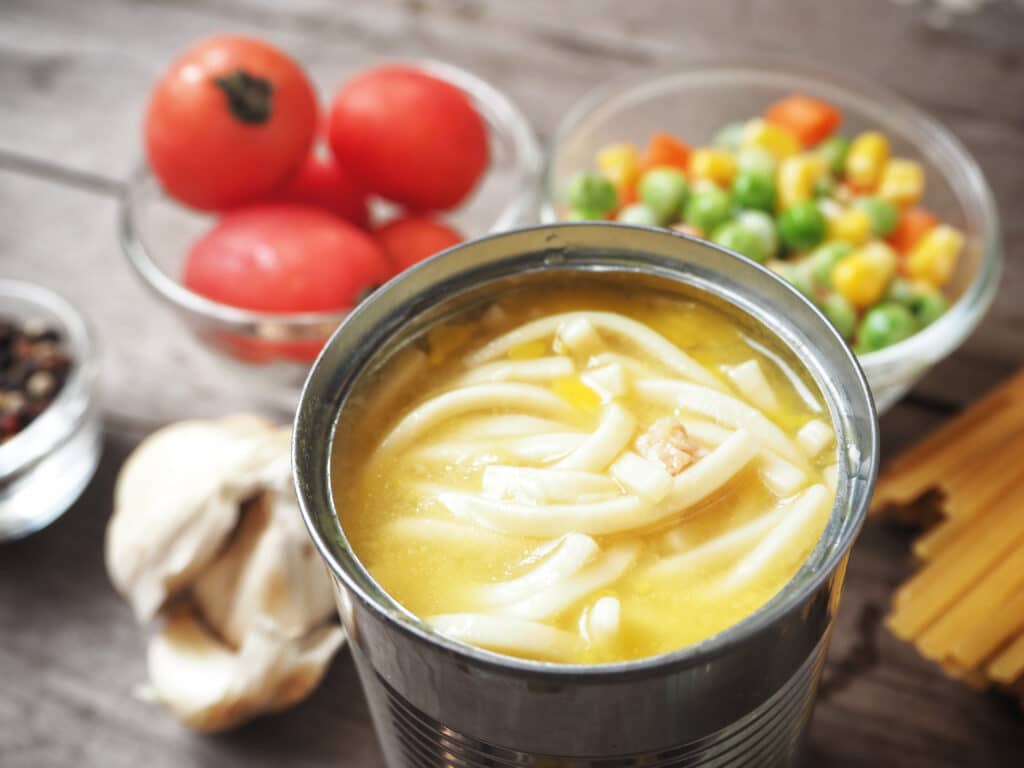
Canned Soup offers a quick and easy meal solution for busy days. It comes in various flavors and types, catering to diverse tastes and dietary needs. Whether you’re looking for a light broth-based soup or a hearty cream-based stew, there’s a canned soup to satisfy your craving.
Different types of canned soup:
-
Broth-Based Soups: These are light and often considered healthy options, such as chicken noodles, vegetables, or beef broth.
-
Cream-Based Soups: Like cream of mushroom, cream of chicken, or celery, offer a richer, more indulgent experience.
-
Chunky Soups: These are filled with large pieces of meats, vegetables, and sometimes grains or pasta, making them a filling meal.
-
Condensed Soups: Typically thicker and meant to be diluted with water or milk, these are versatile and can be used as bases in recipes.
-
Progresso-Style Soups: Known for their wide range of flavors and heartier consistency, often including whole pieces of vegetables and meats.
-
Health-Conscious Soups: Lower in sodium, fat, and calories, designed for those watching their diet.
-
Organic Soups: Made with organic ingredients, catering to those preferring natural and environmentally friendly options.
-
Bisque and Chowders: Rich and creamy, often seafood-based, such as lobster bisque or clam chowder.
-
International Soups: Italian minestrone, Japanese miso, or Mexican tortilla soup, to name a few – bringing flavors from around the world.
-
Vegetarian and Vegan Soups: Plant-based options without any animal products.
10 Unconventional Cooking Hacks That Work Like Magic

Cooking isn’t just about following recipes—it’s about innovation and ingenuity in the kitchen. This concise exploration reveals “10 Unconventional Cooking Hacks That Work Like Magic.” Step into the world of creative cooking, where each hack promises a delightful twist on the ordinary, transforming the mundane into the extraordinary:
Coffee-Free Zone: Discovering 10 Alternative Ways to Function Effectively

For many, a day without coffee seems challenging. “Coffee-Free Zone” presents ten simple, practical tips from seasoned forum users for staying alert and productive without caffeine. Discover these straightforward strategies and keep your energy up, coffee-free:
12 Dishes Foodies Secretly Find Disgusting

Sometimes, even foodies encounter dishes they can’t stomach. “12 Dishes Foodies Secretly Find Disgusting” uncovers the meals that, despite the hype, some find unappetizing. Dive into this list of not-so-favorite foods shared by real food lovers online:






